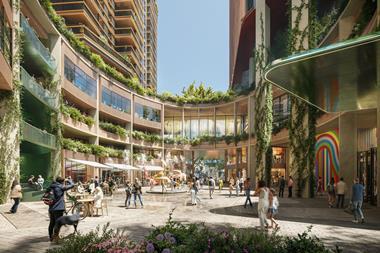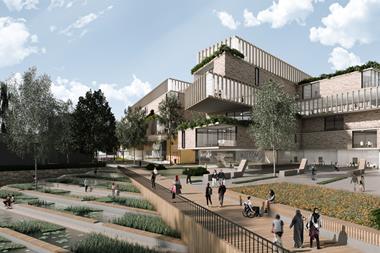People know a great place when they visit one, even after spending only a little time there. The people living and working in the area are visibly proud of their neighbourhood.

The design and development of the streets, public spaces, private residences and local businesses complement each other, creating something that is much greater than the sum of its parts. There is an unmistakable sense of pride in the air at such developments, borne out of a common identity.
We are making great strides in the industry when it comes to mixed-use development. Complex mixed-use development presents many challenges for developers, and balancing the needs and views of many different stakeholders throughout the process is tough, particularly if regeneration is also a factor.
However, with progressive, mixed-use development now being critical to the reinvigoration of towns and cities across the UK, as well as being the key to unlock significant improvements in accommodation and public space in London, it is clearly important that we strive for better ways of doing it – and more importantly, to place human beings at the centre of the process.
The tide is turning and at Navana Property Group we work alongside developers with real vision. But in some cases, the practice of architects working in isolation on a design, which a developer then builds as cheaply as possible by cutting as many corners as the planning system will allow, is still sadly in evidence.
Neglecting to focus on constituents of the new mixed-use place throughout the development process will also result in residents and occupiers interacting with their neighbours as little as possible when they finally move in.
Finally, and almost as an afterthought, a property management company is brought in. They know nothing about the development’s original design or strategy, and what they know about the finished scheme they learn only from the landlord who hired them. Their job is to fix the occasional broken bench or clean the stairwells. For this, they collect a service charge – which everyone typically resents paying.
It is possible for architects, developers, occupiers and property management companies to work together to create mixed-use developments that we can be proud of.
The result? No one is happy, no one is connected and the overall estate lacks cohesion and identity. No one has considered at any stage how the finished product should be managed, activated, or how it might be experienced by the users. And even if this did happen at an earlier stage of the development process, perhaps by the architects, this has been lost in translation by the time the managing agents have been instructed.

In reaction to the anger from occupiers and lack of tangible value from the managing agents, they are often quickly replaced with another. A vicious circle emerges. The revolving door of managing agents fosters more discontent from occupiers, which leads to the departure and arrival of more managing agents, a lack of continuity and erosion of value for everybody.
Collaborative thinking
It doesn’t have to be this way. It is possible for architects, developers, occupiers and property management companies to work together to create mixed-use developments that we can be proud of. But we need to think bigger – and we need to think collaboratively with greater focus on technology.
The first step towards achieving this is recognising that, to most people who work outside of the property industry, the phrase “mixed-use development” is utterly meaningless. People talk about places and neighbourhoods. The aim should be to create somewhere with an identity, somewhere based on common principles that everyone – architects, developers, occupiers, property management companies and local communities – can agree on.
In this scenario, property management companies are not introduced at the last possible moment, when the development is built and the tenants are already or imminently about to move in. Property management companies need to be present right from the start. They need to be liaising with architects to inform how the design of the space should affect the way people behave in it. They need to talk to developers about how the eventual product will be built. And they need to talk to occupiers about what they want from the final development and what would help them to use their spaces more productively and enjoyably.
We have found that the work put into this pre-management phase pays off a hundredfold when occupiers start to move in to the property, not least because back and front-end management technologies can be more efficiently built in to the development at an earlier stage.
What’s more, property management providers shouldn’t be filled with property managers. That phrase suggests the number-one priority is the wellbeing of the buildings, when it should be obvious to anyone that the wellbeing of the people using the place comes first. To that end, the property management company shouldn’t just be chosen by the developer or landlord either.
All managing agents, where feasible, should work in collaboration with residents and potentially also the commercial occupiers to shape how their places are managed. By not consulting the people and entities based on the estate, the implication is that their opinion doesn’t matter. That is not the way it should be. If they are paying for a service, they have a right to provide input on the way their place is managed.
A managing agent needs a clear mandate to help maintain the cohesiveness of a place. Constant feedback from residents and businesses should also be sought to make sure that the service charge is being spent on things occupiers actually need and want.
The key to all of this is conversation: an open dialogue between every stakeholder at every stage of development and occupation. Proper conversation will alleviate any concerns about what a service charge is for and what a property management provider does – or should do.
Technology can be extremely helpful here. A well designed, informative app can be powerful tool for occupiers, landlords and property managers alike. At Navana, we use two apps to do this in our places. The first is a financial tool that gives leaseholders, landlords, developers and investors complete transparency when it comes to service charges through a live, real time link to the bank.
The second app is our community integration tool. It connects local businesses with residents and office workers in the neighbourhood. It allows people to find great places to have coffee and book yoga classes, but it also helps to foster that sense of identity that is so important for creating a place.
It is our belief that management providers should be inherently creative, communications and community-centric in their approach, with in-house experts available to lead on these important disciplines. With the importance of communications and community being plain to see, embracing creativity is also important, as not only does it allow property managers to talk the same language of the other development partners, such as architects, but also adds unique character to the places under their management – for example, through art-based projects or the production and delivery of engaging events and community experiences.
These ideas require work and a complete re-imagining of what a property management company is and what it does. Many outdated companies in the sector will need to be dragged kicking and screaming into the 21st Century, but they will have to change if they want to survive.
At Navana, we welcome this new way of doing things. We want to be involved in every stage of a place’s development — and we are. We want to be committed to creating places that make the UK a better place to live, work, shop and create for everybody.

About Navana
- Navana Property Group is a multi-disciplinary property services provider working in the mixed use, residential and commercial sectors.
- Its capabilities include property and asset management, place and experience consultancy and investment services.
- Navana was launched in 2019 by Harry Fenner, Kelly Bream and Brent Stojanovic, using their extensive industry experience to deliver a more modern, technology-led and responsive property and asset management service.
- Navana is seeking to drive the value back in to property management for everybody, deploying a customer and community based resource model that delivers a better experience, giving clients and residents access to true disciplinary expertise rather than employing teams of property managers.
Time for property to listen and learn
- 1
- 2
- 3
- 4
- 5
 Currently reading
Currently readingThe art of making mixed-use work
- 6
- 7






































No comments yet